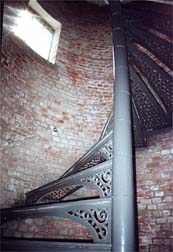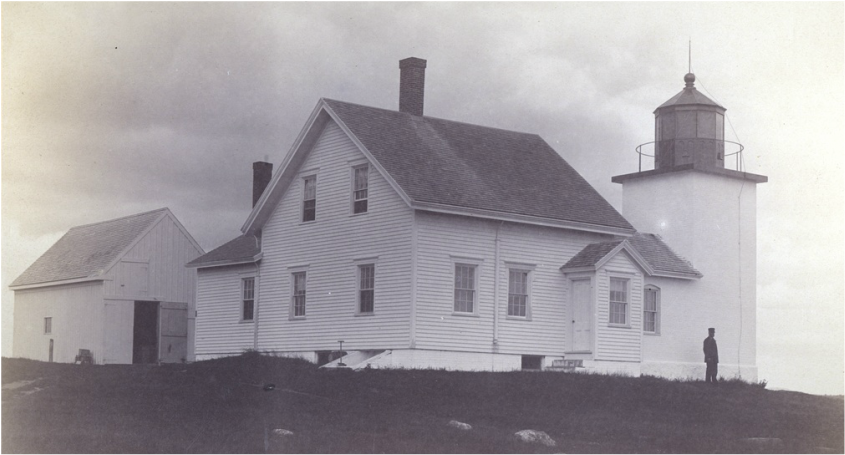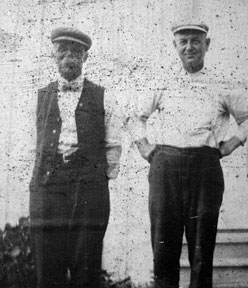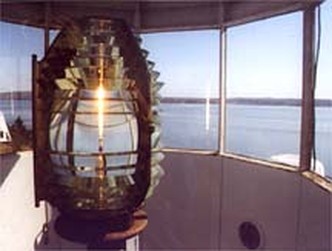History of Fort Point Light, Stockton Springs, Maine
© Jeremy D'Entremont. Do not reproduce any images or text from this website without permission of the author.
Fort Point Light was established in 1836 in Stockton Springs, at the west side of the mouth of the Penobscot River, to aid vessels bound for Bangor, a leading lumber port. The town of Stockton Springs was also a lumber port and a shipping point for Maine's potato industry.

Circa 1859 (National Archives).
The lighthouse gets its name from adjacent Fort Pownall, built by order of Massachusetts Governor Pownall (Maine at that time was part of Massachusetts) in 1759 to guard against the French.
The first lighthouse was a granite tower. The first keeper was William Clewly, who had sold his land to the government for the station.
John Odom was the third keeper, from 1853 to 1861. The nearby location known as Odom's Ledge was named for him. According to Alice Ellis's History of Stockton Springs, “John Odom, Sr., had one hundred acres about three miles from Fort Pownal. He built the first saw mill on the Penobscot River. His sawmill was at the northern part of Sandy Point, at the mouth of the stream coming from Sandy Point Meadow, at the end of what is called the Mill Road. His cabin stood where Lillian Grant's house now stands. Odom's Ledge was named for him."
The present 31-foot square brick lighthouse was built in 1857. A new wood-frame two-story keeper's house, attached to the tower, was built the same year. In 1890, a bell tower and a barn were added, and an oil house was built in 1897. All of these buildings are still standing, making Fort Point Light an unusually well-preserved light station.
The pyramidal bell tower is one of the few left in New England and is listed on the National Register of Historic Places. The bell, replaced by a foghorn, hangs outside the tower.
The lighthouse's 1857 Fresnel lens remains in use.
The first lighthouse was a granite tower. The first keeper was William Clewly, who had sold his land to the government for the station.
John Odom was the third keeper, from 1853 to 1861. The nearby location known as Odom's Ledge was named for him. According to Alice Ellis's History of Stockton Springs, “John Odom, Sr., had one hundred acres about three miles from Fort Pownal. He built the first saw mill on the Penobscot River. His sawmill was at the northern part of Sandy Point, at the mouth of the stream coming from Sandy Point Meadow, at the end of what is called the Mill Road. His cabin stood where Lillian Grant's house now stands. Odom's Ledge was named for him."
The present 31-foot square brick lighthouse was built in 1857. A new wood-frame two-story keeper's house, attached to the tower, was built the same year. In 1890, a bell tower and a barn were added, and an oil house was built in 1897. All of these buildings are still standing, making Fort Point Light an unusually well-preserved light station.
The pyramidal bell tower is one of the few left in New England and is listed on the National Register of Historic Places. The bell, replaced by a foghorn, hangs outside the tower.
The lighthouse's 1857 Fresnel lens remains in use.
For a time, a hotel was in operation close to the lighthouse.

National Archives
Mary Bradford Crowninshield's 1886 book All Among the Lighthouses described the scene at Fort Point Light:
The view up the river is a lovely one from this place, and also seaward, over the bay filled with its many islands, when the day is clear... There were brightly dressed children playing about in the grounds of the hotel, and summer visitors wandering about the wild paths, or walking over by the lighthouse bank, for the hotel and the lighthouse are very near each other.
Because of its beautiful and accessible location, Fort Point Light was a sought-after station for keepers. A total of only four men kept the light from the 1880s into the 1930s.
The view up the river is a lovely one from this place, and also seaward, over the bay filled with its many islands, when the day is clear... There were brightly dressed children playing about in the grounds of the hotel, and summer visitors wandering about the wild paths, or walking over by the lighthouse bank, for the hotel and the lighthouse are very near each other.
Because of its beautiful and accessible location, Fort Point Light was a sought-after station for keepers. A total of only four men kept the light from the 1880s into the 1930s.
A letter submitted by Keeper Ernest Mathie to a newspaper called the Maine Coast Fisherman in September 1956 offered an interesting glimpse of life at the lighthouse:

The oil house
Have been busy mowing lawns and trying to get the spruce green on the windows and doors. The weatherman has kept me mowing lawns on pleasant days when I should be painting. He is not at all cooperative.
There are quite a lot of summer visitors around and the cottages on Fort Point Road are full. Colby Wardwell and family of Bangor are spending the summer at their cottage. The Robert Fosters and many friends are at their summer house for several weeks.
The Clarence Costales and friends and the Mitchells and Hoyts will be along soon for their vacations at their cottages.
There are quite a lot of summer visitors around and the cottages on Fort Point Road are full. Colby Wardwell and family of Bangor are spending the summer at their cottage. The Robert Fosters and many friends are at their summer house for several weeks.
The Clarence Costales and friends and the Mitchells and Hoyts will be along soon for their vacations at their cottages.
Hoyt Chaney's three granddaughters made the headlines in Lubec, saving two young men from drowning. It took quick thinking and prompt work and much courage on the girls part to bring the victims safely ashore. He must be very proud of them and we are also. The time passes quickly and fall weather is here evenings. Our little garden has produced radishes, beet greens, and carrots with cukes to follow. The flowers have been beautiful, nature waters them.

Our old dog, Cody, walked out and started pulling at the bell rope one day last week as a tanker was going in the river. She barked and seemed quite spry for an old lady dog when they saluted. She had an audience at the time and that is what she likes. Am looking forward to my fall vacation. Bye fellow keepers.
(Thanks to Seamond Ponsart Roberts for the transcription of this letter.)
Right: Elizabeth and Keeper Arthur Mitchell by the fog bell. Mitchell was keeper 1929-1952. Courtesy of Arthur Curtis and Fort Point State Park/Terry Cole.
Robert Rae Kinney was the Coast Guard keeper 1958-60. His stepdaughter, Jennifer Fitzpatrick, later recalled:
Our family was stationed there in the late '50s. As a child I played with Colby Wardwell's granddaughter at their beautiful summer place called the Cow Palace. The mile long dirt road to the light brought many visitors, and we always took them up the tower to show off our beautiful piece of heaven.
(Thanks to Seamond Ponsart Roberts for the transcription of this letter.)
Right: Elizabeth and Keeper Arthur Mitchell by the fog bell. Mitchell was keeper 1929-1952. Courtesy of Arthur Curtis and Fort Point State Park/Terry Cole.
Robert Rae Kinney was the Coast Guard keeper 1958-60. His stepdaughter, Jennifer Fitzpatrick, later recalled:
Our family was stationed there in the late '50s. As a child I played with Colby Wardwell's granddaughter at their beautiful summer place called the Cow Palace. The mile long dirt road to the light brought many visitors, and we always took them up the tower to show off our beautiful piece of heaven.
The light was automated in 1988, and Larry Baum was the last Coast Guard keeper at the family station. Baum had previously served 20 months at Great Duck Island Light Station, far offshore. Baum, his wife, Valerie, and their three young daughters -- Katie, Angela, and Jennifer -- appreciated life at Fort Point, close to schools and shopping.
Above, 1988 clip of Larry Baum, the Coast Guard's last keeper at Fort Point Light Station
The lighthouse grounds are now part of Fort Point State Park. From 1988 to 2020, the resident "keepers" for the Maine Bureau of Parks and Lands were Lawrence "Terry" Cole and Jeralyn Cole.

Terry was the keeper at Fort Point Light back when he was in the Coast Guard in the early 1970s, and was thrilled to come back to the station. One of the Coles' daughters was married at the lighthouse.
Left: Terry Cole with his wife Jeri and Molly, the lighthouse dog
Fort Point Lighthouse is a rare case of a square tower on the outside, but inside its brick lining is round, with a circular iron stairway.
The only other lighthouse in Maine that fits this description (to the best of my knowledge) is Deer Island Thorofare Light near Stonington.
Left: Terry Cole with his wife Jeri and Molly, the lighthouse dog
Fort Point Lighthouse is a rare case of a square tower on the outside, but inside its brick lining is round, with a circular iron stairway.
The only other lighthouse in Maine that fits this description (to the best of my knowledge) is Deer Island Thorofare Light near Stonington.
In June 2002, I received the following note from Seamond Ponsart Roberts, whose father Octave Ponsart was keeper at several Massachusetts light stations. It may explain the mystery of why a round stairway was put in a square tower, but it isn't clear whether it refers to Fort Point or Deer Island Thorofare light.

Dad was talking with the government carpenter once and the carpenter, a Mr. Reynolds from Fairhaven, said something like, 'Did ya know there's a light in Maine, square on the outside and round on the inside?' and we were amazed. And he said he was told that at the time they built it, they had an old spiral staircase available, but the plans had called for a square outside. So they made it round for the staircase and then square to match the plans.
Under the Maine Lights Program coordinated by the Island Institute of Rockland, the lighthouse became the property of the State of Maine Bureau of Parks & Land in 1998.
The property is part of the Fort Point State Historic Site , (207) 941-4014.
The light and automatic fog signal remain active aids to navigation and are maintained by the Coast Guard.
Under the Maine Lights Program coordinated by the Island Institute of Rockland, the lighthouse became the property of the State of Maine Bureau of Parks & Land in 1998.
The property is part of the Fort Point State Historic Site , (207) 941-4014.
The light and automatic fog signal remain active aids to navigation and are maintained by the Coast Guard.
The fog bell can be rung manually from inside the tower.
There are signs on U.S. Route 1 in Stockton Springs pointing the way to Fort Point State Park and the lighthouse, and a 200-foot pier is available for visitors arriving by boat.
Keepers: (This list is a work in progress. If you have any information on the keepers of this lighthouse, I'd love to hear from you. You can email me at [email protected]. Anyone copying this list onto another web site does so at their own risk, as the list is always subject to updates and corrections.)
William Clewly (1836-1850); Levi Bowdin (1850-1853); John Odom (1853-1861); Henry Stowell (1861-1866); Hiram Grant (1866-1882); Adelbert Webster (1882-1902); John Thurston (1902-1919); Edward Stevens Farren (1919-1929); Arthur Mitchell (1929-1952); Ernest Mathie (Lighthouse Service, then Coast Guard, 1952-1957); Ernest DeRaps (Coast Guard. 1957-?); Robert Rae Kinney (Coast Guard, c. 1958-1960); Wayne McGraw (Coast Guard); Ray Scarborough (Coast Guard); Gene Benner (Coast Guard); Harry Lahaye (Coast Guard); Terry Cole (Coast Guard, 1973-1976); Paul Munroe (Coast Guard, 1976-1979); ? Smith (Coast Guard); Alan Daniel Achorn (Coast Guard, 1980-1984); Larry Baum (Coast Guard, 1984-1988).
Keepers: (This list is a work in progress. If you have any information on the keepers of this lighthouse, I'd love to hear from you. You can email me at [email protected]. Anyone copying this list onto another web site does so at their own risk, as the list is always subject to updates and corrections.)
William Clewly (1836-1850); Levi Bowdin (1850-1853); John Odom (1853-1861); Henry Stowell (1861-1866); Hiram Grant (1866-1882); Adelbert Webster (1882-1902); John Thurston (1902-1919); Edward Stevens Farren (1919-1929); Arthur Mitchell (1929-1952); Ernest Mathie (Lighthouse Service, then Coast Guard, 1952-1957); Ernest DeRaps (Coast Guard. 1957-?); Robert Rae Kinney (Coast Guard, c. 1958-1960); Wayne McGraw (Coast Guard); Ray Scarborough (Coast Guard); Gene Benner (Coast Guard); Harry Lahaye (Coast Guard); Terry Cole (Coast Guard, 1973-1976); Paul Munroe (Coast Guard, 1976-1979); ? Smith (Coast Guard); Alan Daniel Achorn (Coast Guard, 1980-1984); Larry Baum (Coast Guard, 1984-1988).







